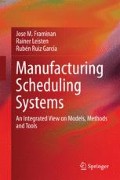Abstract
In this chapter, we approach for the first time the integration of the three elements discussed in precedent chapters (i.e. models, methods and tools) in a manufacturing scheduling system. To do so, we need to gain an in-depth understanding on how the manufacturing scheduling process is carried out and how the three elements can contribute to improve this process.
Access this chapter
Tax calculation will be finalised at checkout
Purchases are for personal use only
References
Baek, D., Oh, S., and Yoon, W. (1999). A visualized human-computer interactive approach to job shop scheduling. International Journal of Computer Integrated Manufacturing, 12(1):75–83.
Beishon, R. (1974). The Human Operator in Process Control, chapter An Analysis and Simulation of an Operator’s Behaviour in Controlling Continuous Baking Ovens, pages 79–90. Taylor & Francis.
Buxey, G. (1989). Production scheduling: Practice and theory. European Journal of Operational Research, 39(1):17–31.
Crawford, S. (2001). Human Performance in Planning and Scheduling, chapter Making Sense of Scheduling: The Realities of Scheduling Practice in an Engineering Firm, pages 83–104. Taylor & Francis.
Crawford, S. and Wiers, V. (2001). From anecdotes to theory: reviewing the knowledge of the human factors in planning and scheduling. In MacCarthy, B. L. and Wilson, J. R., editors, Human performance in planning and scheduling, pages 15–44. Taylor & Francis.
Dessouky, M., Moray, N., and Kijowski, B. (1995). Taxonomy of scheduling systems as a basis for the study of strategic behavior. Human Factors, 37 (3):443–472.
Fox, M. S. and Smith, S. (1984). Isis: A knowledge-based system for factory scheduling. Expert Systems Journal, 1(1).
Freed, T., Doerr, K., and Chang, T. (2007). In-house development of scheduling decision support systems: Case study for scheduling semiconductor device test operations. Int J Prod Res, 45(21):5075–5093.
Goldratt, E. and Cox, J. (1992). The Goal: A Process of Ongoing Improvement. North River Press; 2 Revised edition (January 1992).
Grant, T. J. (1986). Lessons for O.R. from A.I.: A scheduling case study. Journal of the Operational Research Society, 37 (1):41–57.
Haider, S. W., Moodie, C. L., and Buck, J. R. (1981). An investigation of the advantages of using a man-computer interactive scheduling methodology for job shops. International Journal of Production Research, 19(4):381–392.
Halsall, D. N., Muhlemann, A. P., and Price, D. H. (1994). A review of production planning and scheduling in smaller manufacturing companies in the uk. Production Planning & Control, 5(5):485–.
Herrmann, J. (2006). Handbook of Production Scheduling, chapter Decision-Making Systems in Production Scheduling, pages 91–108. Springer.
Higgins, P. G. (1996). Interaction in hybrid intelligent scheduling. International Journal of Human Factors in Manufacturing, 6(3):185–203.
Hopp, W. J. and Spearman, M. L. (1996). Factory physics. Foundations of manufacturing management. Irwin, New York, USA.
MacCarthy, B. (2006). Handbook of Production Scheduling, chapter Organizational, systems and human issues un production planning, scheduling, and control, pages 59–90. Springer.
MacCarthy, B. L. and Wilson, J. R., editors (2001). Human performance in Planning and Scheduling. Taylor & Francis.
McKay, K. and Buzacott, J. (2000). Application of computerized production control systems in job shop environments. Computers in Industry, 42(2):79–97.
McKay, K., Buzacott, J., Charness, N., and Sayafeni, F. (1992). Artificial Intelligence In Operational Research, chapter The Scheduler’s Predictive Expertise: An Interdisciplinary Perspective, pages 139–150. Macmillan.
McKay, K. and Wiers, V. (2006). Handbook of Production Scheduling, chapter The Human Factor in Planning and Scheduling, pages 23–57. Springer.
McKay, K. N., Safayeni, F. R., and Buzacott, J. A. (1995a). “Common sense” realities of planning and scheduling in printed circuit board production. International Journal of Production Research, 33(6):1587–1603.
McKay, K. N., Safayeni, F. R., and Buzacott, J. A. (1995b). Review of hierarchical production planning and its applicability for modern manufacturing. Production Planning and Control, 6(5):384–394.
McKay, K. N. and Wiers, V. C. S. (1999). Unifying the theory and practice of production scheduling. Journal of Manufacturing Systems, 18(4):241–255.
Nakamura, N. and Salvendy, G. (1994). Design of Work and Development of Personnel in Advanced Manufacturing, chapter Human Planner and Scheduler, pages 331–354. Wiley.
Norman, P. and Naveed, S. (1990). A comparison of expert system and human operator performance for cement kiln operation. Journal of the Operational Research Society, 41 (11):1007–1019.
Randel, J. and Pugh, L. (1996). Differences in expert and novice situation awareness in naturalistic decision making. International Journal on Human Computer Science, 45:579–597.
Sanderson, P. and Moray, N. (1990). Ergonomics of Hybrid Automated Systems II, chapter The Human Factors of Scheduling Behaviour, pages 399–406. Elsevier.
Shobrys, D. and White, O. (2000). Planning, scheduling and control systems: Why can they not work together. Computers and Chemical Engineering, 24(2–7):163–173.
Stoop, P. and Wiers, V. (1996). The complexity of scheduling in practice. International Journal of Operations and Production Management, 16(10):37–53.
Thurley, K. and Hamblin, A. (1962). The supervisor’s role in production scheduling. International Journal of Production Research, 1:1–12.
Vera, A., Lewis, R., and Lerch, F. (1993). Situated decision-making and recognition based learning: Applying symbolic theories to interactive tasks. In 15th Annual Conference of the Cognitive Science Sociey, University of Colorado-Boulder, pages 84–95.
Vernon, C. (2001). Lingering amongst the lingerie: An observation-based study into support for scheduling at a garment manufacturer. In MacCarthy, B. and Wilson, J., editors, Human performance in planning and scheduling, pages 135–163. Taylor & Francis.
Webster, S. (2001). A case study of scheduling practice at a machine tool manufacturer. In MacCarthy, B. and Wilson, J., editors, Human performance in planning and scheduling, pages 67–81. Taylor & Francis.
Wiers, V. (1996). A quantitative field study of the decision behaviour of four shopfloor schedulers. Production Planning and Control, 7(4):383–392.
Wiers, V. (2001). Design of knowledge-based scheduling system for a sheet material manufacturer. Human Performance in Planning and Scheduling, pages 201–215.
Author information
Authors and Affiliations
Corresponding author
Rights and permissions
Copyright information
© 2014 Springer-Verlag London
About this chapter
Cite this chapter
Framinan, J.M., Leisten, R., Ruiz García, R. (2014). Overview of Scheduling Systems. In: Manufacturing Scheduling Systems. Springer, London. https://doi.org/10.1007/978-1-4471-6272-8_13
Download citation
DOI: https://doi.org/10.1007/978-1-4471-6272-8_13
Published:
Publisher Name: Springer, London
Print ISBN: 978-1-4471-6271-1
Online ISBN: 978-1-4471-6272-8
eBook Packages: EngineeringEngineering (R0)

